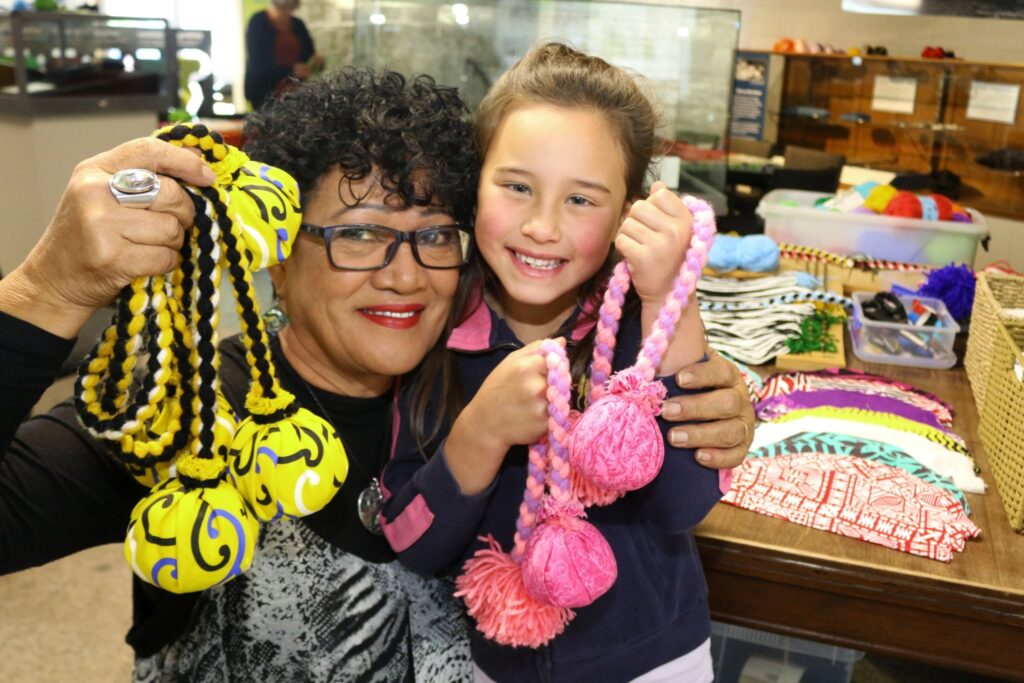Poi making part of festival

Caption: POI master Rangipai Martin (left) and seven-year-old Chiara Young O’Keeffe from Aria had loads of fun making poi at the poi-making workshop at the Mokau Museum on Saturday.
By Dan Tasker
King County News
A RECENT poi-making workshop in Mokau helped locals celebrate Matariki as the Māori New Year festivities drew to a close last week. The rising of the Matariki star cluster signals the beginning of the Māori New Year, which has traditionally been celebrated as a time of remembrance and renewal.
Part of the way Māori have commemorated Matariki in the past was through coming together as whanau for entertainment to learn and play games. In a modern day Matariki setting, Tongaporutu resident Rangipai Martin has run two poi-making workshops at the Mokau Museum through the Matariki period.
MAKE AND USE
The workshops attracted more than a dozen adults and children who not only learnt how to make poi, a skill toy used in traditional Māori dancing, but also the basics of how to use them.
The novice poi-makers picked a third colour to go with the black and white wool used in making the poi’s plait, before making the plait, filling a fabric ball with handy towels to tie on one end of the plait before making a pom-pom to go on the other end.
Rangipai said it could take several hours for beginners to finish their poi, but eventually they would get a better feel for the rhythm of the process.
“Learning the full plait is the hardest. It might take an hour or two when you’re just learning – there’s a real art to it. We’ve had quite a few people come through the last two weeks – the kids absolutely love it.”
CO-ORDINATION
In recent times, Rangipai has been also teaching the art of using poi to the students at Mokau School as a way of teaching Māori culture and physical and mental co-ordination.
It’s been a cultural revival of sorts for Rangipai, who decided to stay in New Zealand when she got stuck here during the first Covid-19 lockdown, after 40 years living in Australia as a mental health nurse and a mother to three sons.
Being of Maniapoto descent from the Waikorara hapu, home eventually called Rangipai back, quickly re-establishing her love of poi by designing her ‘Te Poi o Rangipai’ collection with the help of her sister.
“I always practised, I always made them as gifts and gave them away, but when I came back here, I thought I’d get back into my poi,” Rangipai said.
The collection is full of vibrancy and colour with designs telling the unique korero and kaupapa reflecting the essence of Māori culture.
AMAZED
As most Māori and some pākeha children do, Rangipai was taught how to use poi as a seven-year with Ngati Poneke in Wellington – learning the double long, the single short, the single long, the two poi together and the full poi.
As she has introduced her collection and the classic arm movement and swaying art of the long poi to the community, Rangipai said she has been amazed at how many people learnt poi as kids have forgotten it as adults.
REMEMBERING
“Everyone knows how to do the poi especially when they were younger and they’ve never picked them up again. They’ll say: ‘I remember doing it when I was a kid, but I haven’t done it since then’.
“We’ll have people walking into the museum that come in and see the poi.
“These are ladies in their 70s and they pick it up and start swinging and they say: ‘I’ve forgotten how much fun this was’.”
As a nurse specialising in dementia and Alzheimer’s disease as well as having raised a son with autism, Rangipai has also witnessed the benefits poi has for the co-ordination and wellness of those with mental health.
“When you look at mental health and kids people put down and make them feel useless, this is something they can pick up and do on their own. “It helps the left side of the brain; some children can’t do left things whereas this teaches their brain to go left and right and move at the same time.
“To me children [who] have a mental health problem or depression, [using poi] works. I’ve seen so many children who thought they couldn’t do it, but they ended up doing it for themselves.”



